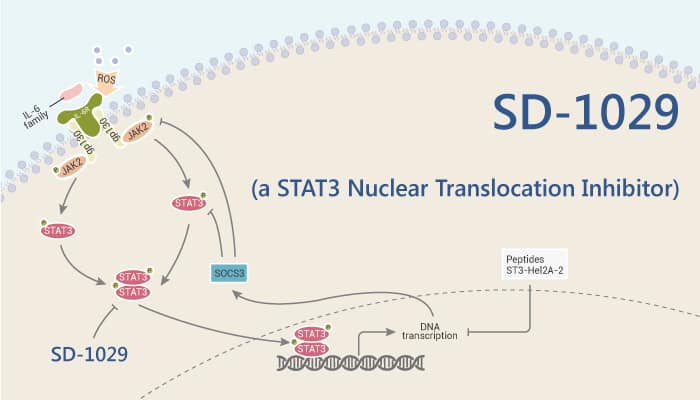Janus kinase (JAK) is a family of intracellular, nonreceptor tyrosine kinases that transduce cytokine-mediated signals via the JAK-STAT pathway. JAK includes JAK1, JAK2, JAK3 and TYK2. JAK serves as the cytoplasmic signaling components of cytokine receptors and are activated through cytokine-mediated trans-phosphorylation. The pseudokinase domain of JAKs is crucial for maintaining a low basal (absence of cytokine) level of tyrosine kinase activity. In particular, gain-of-function mutations in the JAK genes, most frequently, V617F in the pseudokinase domain of JAK2, have been mapped in patients with blood disorders. Mutations in JAK2 plays an inportant in polycythemia vera, essential thrombocythemia, and myelofibrosis as well as other myeloproliferative disorders.
The signal transducer and activator of transcription (STAT) proteins are a family of cytoplasmic transcription factors. The mammalian STAT family comprises STAT1, STAT2, STAT3, STAT4, STAT5a, STAT5b and STAT6 that mediate multiple intracellular signaling pathways. Among them, STAT3 plays an important role in numerous biological processes including cell proliferation, survival, differentiation, and angiogenesis. In normal cells, transient activation of STAT3 transmits transcriptional signals from cytokines and growth factor receptors at the plasma membrane to the nucleus. In contrast, STAT3 becomes hyperactivated in the majority of cancers. Therefore, it is not surprising that STAT3 signaling pathway has long been recognized as a potential therapeutic target for cancer therapy owing to their roles in tumor formation, metastasis and drug resistance. Moreover, accumulating evidence reveals that STAT3 hyperactivation can mediate tumor-induced immunosuppression at many levels.
SD-1029 is a JAK2/STAT3 activation inhibitor.

SD-1029 inhibits autophosphorylation of recombinant JAK2 and decreases levels of phosphorylated JAK2, but not JAK1 or Src. Meanwhile, SD-1029 also can inhibit STAT3 nuclear translocation. In vitro, SD-1029 inhibits cell growth and induces apoptosis in human liver, breast and ovarian cancer cell lines. SD-1029 also enhances apoptosis induced by paclitaxel in ovarian cancer cells. All in all, SD-1029 directly abrogates the Jak-Stat3 signaling pathway in human cancer cells expressing constitutively active Stat, and add to the growing literature that validates this pathway as a viable target for further drug development.
Reference:
[1]. Hubbard SR. Front Endocrinol (Lausanne). 2018 Jan 5;8:361.
[1]. Zou S, et, al. Mol Cancer. 2020 Sep 24;19(1):145.